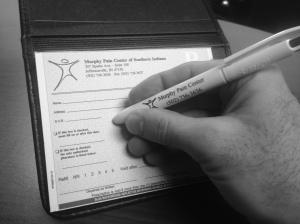THE CHRONIC PAIN PATIENT’S GUIDE
TO KENTUCKY’S REGULATIONS

Even though I’m on the lowest dose possible to keep my chronic pain under control I still worry this too will be taken away. At each appointment I get scared I will be told my doctor can no longer prescribe what little medication I do get. I appreciate the pain relief I do get, it means more to me than people can imagine.
~Samuel
October 1, 2014 at 7:47 PM
People with pain must recognize that they have a role to play in making sure these medications remain available, as needed, to all.
~Steven D. Passik, PhD
Abstract: This is a summary of how chronic pain patients can effectively prepare for a productive and meaningful visit with their Kentucky physician to address pain care options -especially when care involves the use or potential use of controlled substances. The goal is that patients and physicians will work together to maximize the therapeutic benefits and minimize the inherent risks to patients, physicians, and society.
Pain is the most common reason patients see physicians. We all feel pain, but everyone experiences pain in a unique way. There are many ways to treat pain, but treatment is best when tailored to the needs of the individual. Sometimes adequate pain treatment requires drugs (i.e. “controlled substances”) that expose users to risks of addictions, abuse and misuse. In these cases, patients and physicians must work together to minimize these risks.
It has been estimated that in the U.S. there is only one pain specialist for every 26,000 patients with chronic pain. Thus the majority of chronic pain treatment remains in the hands of primary care physicians.
Treating chronic pain can be straightforward when the primary focus is providing relief. But inescapable concerns about potential drug abuse and regulatory scrutiny can make treating chronic pain very complex and stressful for patients and physicians.
Most states have specific prescribing regulations that sometimes are inadequately communicated and poorly understood. This contributes to physician anxiety and adds to the physicians’ clinical, legal, and administrative burdens.
The patient-physician relationship must be a true partnership based on respect, trust, honesty, and clear communication. The following is a summary of what patients can do to help their physician partners.
*
The Chronic Pain Patient’s Guide to Kentucky’s Regulations
General Recommendations:
- Prepare answers to some basic medical history questions.
- Obtain copies of pertinent documents and medical records.
- Make a list of your healthcare providers along with their contact information.
- You may wish to store the data on a flash drive, CD/DVD or upload to a secure website for retrieval by your physician. Be advised, until you give these documents to your physician you are responsible for keeping them private.
- Bring a friend or family member with you for support, assistance with questions, and to help verify information.
For the initial visit prepare the following:
- Medical history
- Medical records
- Medications
- Substance use
- Social and family history
- Other medical issues
- Education and consent
- Ability to function
- Goals
- Questionnaires / mental health screen
- Medical history.
It begins with your “Chief Complaint.” This is where you tell your physician what hurts.
Chief complaint: My pain is _______________________
For example: “My pain is in my low back.”
Next, fill in some DETAILS about your pain:
(i) Cause. Based on what you know about your condition, what do you think is causing your pain?
Examples: a bad disk / pinched nerve / arthritis, etc. Be as specific as you can.
(ii) Location. Where does it start? Where does it go?
(iii) Quality. Sharp? Aching? Electrical? Sensitive to touch?
(iv) Symptoms. Numbness? Tingling? Weakness? Muscle wasting? Skin color changes? Swelling?
(v) Timing. Started when? Is it constant? Variable? Worse at certain times of the day? Lasts how long?
(vi) Aggravating factors. What makes it worse? Bending? Standing? Twisting? Being anxious? Working?
Housework? Sleep?
(vii) Relieving factors. What makes it better? Resting? Heat? Ice? Massage? Medication? Injections? Being
distracted? Sleep?
(viii) Pain scale. Rate your pain on a scale from: ZERO (no pain) to TEN (worst pain imaginable).
- Medical records.
Your physician may not need every record, but information about care related to your pain is useful and includes:
- Surgery reports related to your pain (back surgeries, etc.);
- Laboratory tests (blood tests, urine drug screens, etc.);
- Studies (x-rays, MRI, CT, EMG, etc.);
- Pain care treatments (epidurals, physical therapy, acupuncture, chiropractic, etc.);
- Consultations with specialists (surgeons, pain, chiropractic, mental health).
Make a list of your diagnostic tests, especially the most recent ones; include dates and contact information. Gather the reports. If you wait for your physician to get the reports faxed, your pain care could be delayed significantly. You may want to copy them onto a flash drive, CD/DVD, or to a secure website.
- Medications.
(a) An accurate and current medication list is extremely important. Include the date, dosage, quantity, and directions. Bring the medicine bottles with you and/or labels, written prescriptions, etc.
Provide answers to these questions:
- Do you find your current medications to be effective?
- Are you taking them the way they have been prescribed for you?
- How long have you been on your current medications?
- When was the last time you had a medication change?
- Are they causing you any unacceptable side effects such as: sedation, fatigue, nausea, constipation, etc.?
(b) Your medication “journey.” It is extremely important for your physician to know (and document) how you got to this point. What medications did you use in the past? Did you try some over-the-counter medications? Non-controlled substance prescriptions? Gather records (medical, pharmacy, etc.) to show how your dosages have changed over time.
(c) If you have a prescribing “agreement” with another physician, bring a copy.
- Substance use.
It is vital to be forthcoming about any substance abuse or any substance abuse treatment involving you or any close relative (especially a mother, father, son or daughter). And report any drug-related arrests?
Do you drink alcohol? Do you smoke?
Remember to drink plenty of fluids before your visit in case you are asked to provide a specimen for a random urine drug screen.
- Social and family history.
Where do you live and with whom?
Is your home life a challenge?
What is your occupation? Are you disabled?
Where do you get money to live on?
How much formal education have you had?
- Other medical issues.
Are you dealing with any other medical issues such as: diabetes, heart disease, cancer, etc.? When was your last general medical evaluation?
Note: To receive long-term controlled substances for pain in Kentucky, it is mandatory that you have a yearly preventive health evaluation.
- Education and consent.
Show that you have educated yourself about controlled substances and prepare to document your “informed consent.”
(a) The Kentucky Board of Medical Licensure has posted educational points of emphasis on their website.
I have prepared an educational summary for both Kentucky and Indiana which is available here: http://goo.gl/IJ4I1l
Or download the Murphy Pain Center New Patient Package. Study the patient education sheet. Print it out. Sign it. And bring it with you.
Watch this outstanding video by Dr. Mike Evans that explains many of the pros and cons of the use of controlled substances for chronic pain care.
(b) Once you have been informed, you are ready to give your “informed consent.” You may download this document and bring it to your physician:
I have written an article about informed consent and treatment agreements, Are We In Agreement, available on my website: Confluential Truth.
- Ability to function.
Describe your current ability to participate in life’s activities. This will give your physician a baseline from which to judge your progress. You may visit the website for ICSI (Institute for Clinical Systems Improvement) and download and complete the form in Appendix C: Physical Functional Ability Questionnaire (FAQ-5).
- Goals.
Come up with some specific and realistic goals that might be attainable. Think of how you can show when you have achieved them. Within reason, think about what you would like to do that you cannot do now. Be prepared to demonstrate this to the physician; i.e. walk without a cane, bend to pick up something, rise from a chair unassisted.
Set goals that are SMART: specific, measurable, attainable, realistic, and track-able.
- Questionnaires / Mental Health Screen
Complete these “screening” questionnaires and bring them to your visit.
You may go to the Kentucky Board of Medical Licensure website, download these self-report questionnaires, fill them out, and bring them to your office visit.
- Opioid Risk Tool
- Patient Health Questionnaire (PHQ-9), mental health screen
You may also go to the website for ICSI (Institute for Clinical Systems Improvement) and download and complete these two forms:
Appendix A (Brief Pain Inventory); and
Appendix B (Patient Health Questionnaire PHQ-9)
*
If this all seems a bit overwhelming, you can begin to simplify matters by visiting the Murphy Pain Center website and downloading the “New Patient Package.” In it you will find policies, consent forms, agreements, educational materials, and a “New Patient Evaluation” form. These are the kinds of materials you will likely be filling out at your physician’s office visit. Having this information on hand can make your visit more productive.
In conclusion: Due to growing concerns about drug abuse, coupled with layer upon layer of regulations, physicians are becoming increasingly anxious about prescribing controlled substances for patients suffering in chronic pain.
This has been a summary of how a chronic pain patient can effectively prepare for a productive and meaningful visit with his or her physician to address pain care options -especially when care involves the use or potential use of controlled substances. The goal is that both parties will work together to maximize the therapeutic benefits and minimize the inherent risks to patients, physicians, and society.
When patients are adequately prepared, physicians can feel more comfortable, and patients can more likely receive safe, effective, and proper pain care.
It is a partnership.
Note: For the purposes of this summary “controlled substances” refers to CSA scheduled drugs 2 – 4 (Schedule 5 drugs are exempt from Kentucky’s regulations).
Note: Kentucky’s regulations do not apply if the patient is being treated:
(a) in hospice or “end-of-life” treatment;
(c) for cancer pain or pain associated with the treatment of cancer;
(b) in a licensed hospital as inpatient, outpatient, or observation status
(d) as a registered resident of a long-term-care facility
(e) during a disaster or mass casualty situation
(f) as a single dose for a diagnostic test or procedure
So now that you know the pathway…
James Patrick Murphy, MD, MMM is Chair of the Board of Governors -and Immediate Past President- of the Greater Louisville Medical Society, Medical Director of Murphy Pain Center, and an Assistant Clinical Professor at the University of Louisville School of Medicine. Dr. Murphy contributes to numerous publications, has presented before national and international audiences, and consults with a wide spectrum of agencies and individuals regarding pain, addiction, and the future of healthcare in our country. He is board-certified in Pain Medicine, Anesthesiology, and Addiction Medicine.
*
References and links pertaining to this article are provided in the comments.
*




